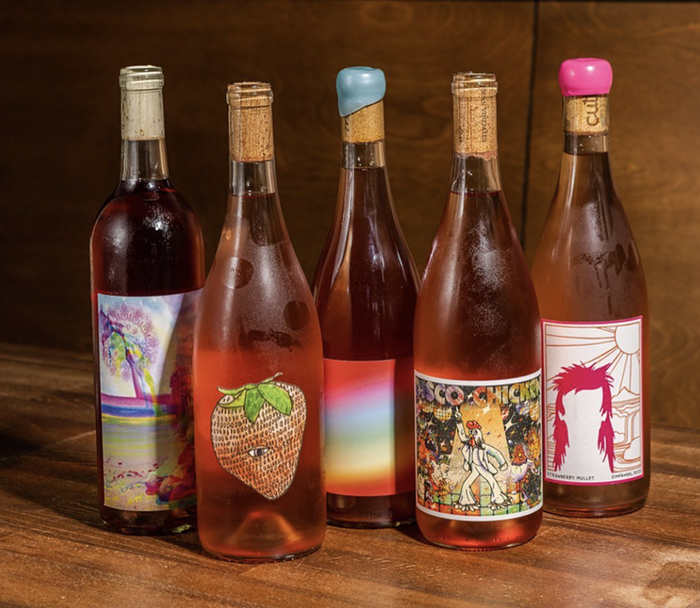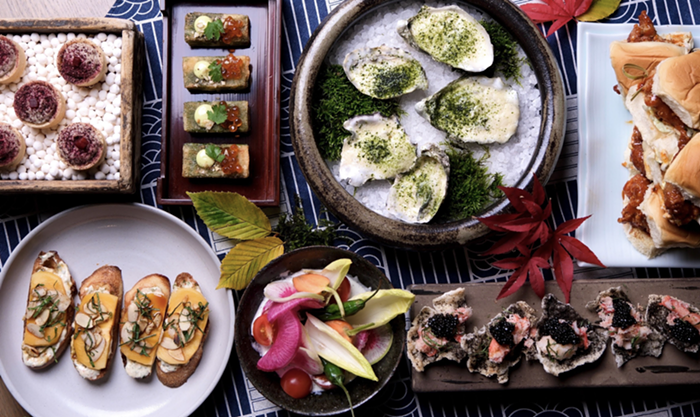Saint Gratus of Aosta, who lived and died sometime in the 400s, is the patron saint of insectophobes. He's also supposed to be handy against animal attacks, fire, hail, lightning, storms, witches, and insect plagues. In 1450, desperate farmers in the French Alps invoked his name and vanquished hordes of the ravenous little monsters. Or so David George Gordon, Seattle's premier bug chef, told 50 or so insect-eaters crammed around folding tables covered in white tablecloths at Cafe Racer last Wednesday night.
"Saint Gratus also carried the head of John the Baptist back to Rome!" Gordon announced enthusiastically. The crowd, which had been raucous and chatty up to that point, fell into a silence. Gordon shrugged: "Well, I guess that was important to somebody!" That got a laugh.
We were ostensibly gathered at Cafe Racer (home to cheap beer, live music, scooter fetishists, and a small museum devoted to bad art) to celebrate the Catholic feast day of Saint Gratus. But the crowd seemed less interested in the saint than in eating his ancient arthropod foes, as prepared by Gordon, author of the Eat-a-Bug Cookbook. On the $20 prix fixe menu: teriyaki locusts on skewers, mealworm pâté, orzo with cricket nymphs, and a salad with Changbai ants—which, according to some Chinese physicians, are good for treating rheumatoid arthritis, asthma, cirrhosis, indigestion, impotence, back pain, coronary heart disease, and lots of other stuff. To drink: "bug juice," a sticky-sweet punch that tasted like summer camp and was dyed with dactylopius coccus, a standard coloring agent in foods and cosmetics. (Beer and wine cost extra—lots of people drank tallboys.)
Gordon wants us to know that we are all entomophages, whether we know it or not.
The chef finished his opening remarks, asked the diners to "set aside our hate and fear" of bugs, and handed a plate of just-fried tempura-battered tarantula to musician Shmootzi the Clod (formerly of Circus Contraption). "Would you mind carving them up?" he asked, adding, "Don't eat them all yourself." Shmootzi obliged and tiptoed around the room, handing out crunchy bits of tarantula leg. It tasted slightly salty, like it could have come from the sea.
Shmootzi's band, called God's Favorite Beefcake, serenaded the room with songs that sounded like a combination of klezmer, cirque noir music, and old Preservation Hall–style jazz. "I can't imagine a better soundtrack to eat bugs to," said a man who was guzzling beer in honor of his birthday. The diners quickly warmed up to each other, dropping decorative plastic flies in each other's wine glasses and telling stories about previous bug-eating experiences. A self-professed "tech monkey" for Amazon.com recalled eating deep-fried honeybees in Mexico. He said they tasted like popcorn. The birthday boy insisted that "every beekeeper eats the larvae, the brood." As the skewers of teriyaki locusts made their way around the table, he opined that they had the texture of toasted pumpkin seeds—a softened carapace, a little fibrous, inoffensive. His tablemates nodded in agreement.
It was more difficult to distinguish the flavor of the little black Changbai ants sprinkled over the summer salad—someone said they tasted "nutty," but I could only taste the overgenerous dose of vinaigrette dressing.
Gordon had assembled an adventurous crowd—who else would show up to a bug banquet?—but people seemed nervous about the mealworm pâté. "Is it going to be just, like, worms?" somebody asked. "I don't know if I can do that," somebody else said. But the dish was more like a mildly flavored meat loaf—ground-up protein (with bonus bacon) wrapped in a flaky, golden crust. While people dug into their "orthopteran orzo" (like any other orzo, but tossed with vegetables and crunchy baby crickets), Shmootzi crooned apocalyptic songs: "Playing hot potato with a hand grenade/Shaking like a leaf on a tree... Oh fuck, it's the end of the world/And don't you come a-crawlin' to me."
The entire evening had an eschatological undercurrent. Some talked about the decimation of honeybee populations across the United States and Europe. One guy waiting for a drink at the bar watched plates of bugs come out of the kitchen and said, "So this is what we're all going to be eating after the big collapse." In a small upstairs room, entomologist Don Ehlen showed off his collection of moths, butterflies, beetles, scorpions, and spiders. "Wow, man," Shmootzi said, pointing at a butterfly with enormous, iridescent blue wings. "If you want to believe in God, take a look at this." The trombone player pointed at another butterfly whose transparent wings were laced with intricate black veins: "That's a French-lingerie butterfly!"
Back downstairs, people savored the rich molasses flavor of Gordon's excellent shoofly pie—flies not included—and asked when they could expect the next bug banquet. Gordon said he was planning on the next feast of Saint Gratus, on September 7, 2012. He was greeted with protests.
So on behalf of Seattle's new entomophiliacs, I would like draw David George Gordon's attention to the existence of several other feast days dedicated to saints who specialize in bugs—infestations of, fear of, and bites from: Saint Narcissus (October 29), Saint Mawes (November 18), Saint Dominic of Silos (December 20), Saint Mark the Evangelist (April 25), Saint Vitus (June 15), Saint Magnus of Füssen (September 6), and lots more.
Don't make us wait, Mr. Gordon. ![]()


















